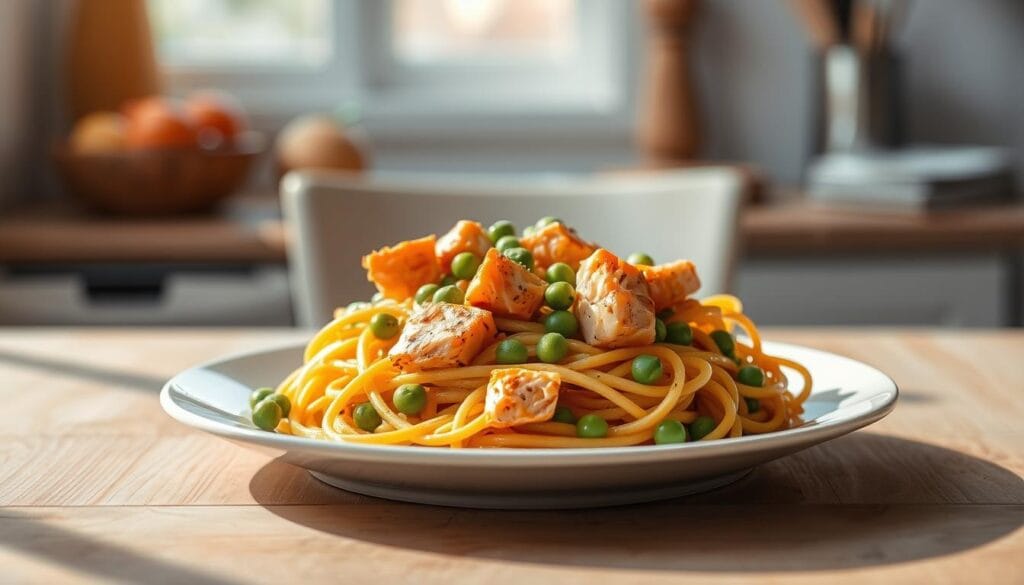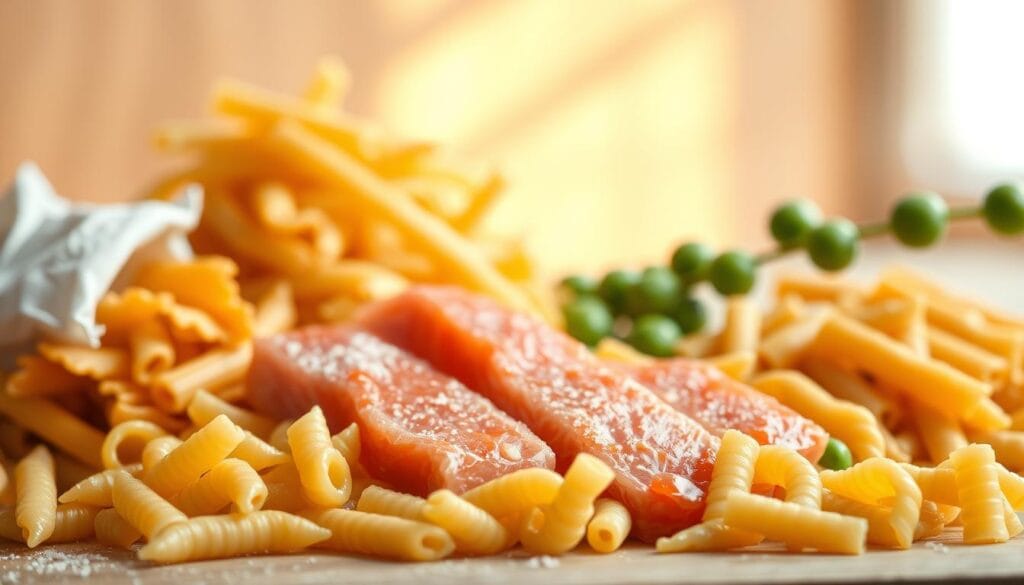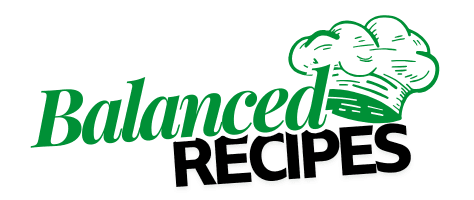Pasta with Salmon Peas
Every home cook dreams of making a meal that feels like it’s from a fancy restaurant. Pasta with salmon peas is more than just dinner. It’s a journey that turns simple ingredients into something amazing.
The first time I made this seafood pasta, I was blown away. Fresh salmon, tender peas, and perfectly cooked pasta came together in one incredible dish. It was effortless.
This seafood pasta recipe is quick and nutritious, perfect for busy weeknights. It’s great for family dinners or a romantic evening. You’ll get flavor and sophistication in under 30 minutes.
Table of Contents

Key Takeaways
- Seafood pasta can be quick and easy to prepare
- Salmon and peas create a nutritionally balanced meal
- Restaurant-quality dishes are possible at home
- This recipe works great for both weeknight dinners and special occasions
- Minimal ingredients can produce maximum flavor
The Perfect Combination of Salmon, Pasta, and Fresh Peas
Making a tasty salmon pasta recipe is a fun journey. It combines protein-rich salmon, comforting pasta, and fresh peas. This mix of flavors and nutrients turns a simple meal into a special treat.
Health Benefits of a Nutritional Powerhouse
Your pea pasta with salmon is a nutritional dream team. Salmon is full of protein and omega-3s, good for your heart. Peas add vitamins and fiber. Pasta gives you energy.
- Salmon: Rich in protein and omega-3 fatty acids
- Peas: Packed with vitamins A, C, and K
- Pasta: Provides complex carbohydrates for sustained energy
Why These Ingredients Complement Each Other
The secret of a great salmon pasta recipe is its taste and texture. Salmon’s rich flavor goes well with peas’ sweetness. Pasta adds a smooth base for these stars.
| Ingredient | Flavor Profile | Nutritional Benefit |
|---|---|---|
| Salmon | Rich, buttery | High protein, omega-3 fatty acids |
| Peas | Sweet, fresh | Vitamins, fiber, low calories |
| Pasta | Neutral, comforting | Complex carbohydrates, energy |
Knowing what makes salmon, peas, and pasta special helps you make a meal that’s both tasty and healthy. This salmon pea pasta mix shows that eating well can be fun and fulfilling.
Essential Ingredients for Your Salmon Pasta Creation
To make the perfect creamy salmon pasta, you need the right ingredients. These ingredients will make your salmon pea linguine taste amazing. Start by picking the best parts for a dish that feels like it came from a fancy restaurant.
Here are the main ingredients you’ll need for a great salmon pea linguine:
- Fresh salmon – Pick wild-caught or top-notch farm-raised salmon for the best taste and texture
- Linguine pasta – The perfect base for your creamy salmon pasta
- Fresh or frozen green peas
- Heavy cream or half-and-half
- Unsalted butter
- Fresh garlic
- Parmesan cheese
There are also some optional ingredients that can make your creamy salmon pasta even better:
- Fresh dill or chives for garnishing
- Lemon zest for a burst of freshness
- Red pepper flakes for a bit of spice
- White wine for more depth
When picking salmon, look for firm, bright fish without a strong smell. Using fresh ingredients is crucial for a salmon pea linguine that will wow your guests.

Choosing the Right Pasta Shape for Salmon and Peas
Finding the perfect pasta shape can make your penne with salmon and peas dish amazing. The right pasta boosts flavor and makes eating more fun.
Your pasta choice greatly affects the taste and feel of your lemon dill salmon pasta. Each shape works differently with sauces and ingredients. This creates unique textures and flavors.
Pasta Shapes That Complement Creamy Sauces
- Penne: Ideal for creamy sauces with its ridged exterior and hollow center
- Fusilli: Spiral shape captures sauce exceptionally well
- Rigatoni: Large tubes that hold thick, creamy sauces
- Farfalle: Bow-tie shape provides excellent sauce coverage
Sauce Retention Techniques
Different pasta shapes hold sauce in different ways. Tubular and ridged pastas like penne with salmon and peas are great for creamy sauces. Their textured surfaces help sauce stick better.
When making your lemon dill salmon pasta, think about pasta shapes with:
- Ridged surfaces
- Hollow or curved designs
- Enough surface area to capture sauce
Try out different shapes to find your favorite pasta and sauce combo. The right shape can turn your dish into a restaurant-quality meal.
Preparing Fresh Salmon for Your Pasta Dish
Starting an easy salmon pasta dish means choosing the right salmon. The fish you pick can make your meal amazing. Look for fresh, high-quality salmon with a bright color and firm texture.
To get your salmon ready for the pasta, follow these steps:
- Check for pin bones using tweezers
- Remove the skin if desired
- Cut salmon into bite-sized pieces for even cooking
Seasoning is key in an easy salmon pasta dish. Salt and pepper are your base seasonings. But feel free to try new things. A bit of dill, lemon zest, or garlic powder can make your dish stand out.
For cooking salmon, pat it dry before seasoning. This helps get a great sear. It makes the salmon golden and keeps it tender.
- Use a sharp knife for clean cuts
- Cut against the grain for most tender pieces
- Aim for uniform chunk sizes
For a great salmon pasta dish, treat your fish with care. Fresh, well-prepared salmon turns a simple pasta meal into a special dish. It will wow your family and friends.
Pasta with Salmon Peas: Step-by-Step Instructions
Making a tasty one-pot salmon pasta is simpler than you think. This recipe turns basic ingredients into a meal that will wow your loved ones. Let’s go through the steps to make pasta with salmon peas.
Creating this dish needs focus and some special techniques. The key to a great pasta with salmon peas is to handle each ingredient and cooking step carefully.
Cooking the Pasta to Perfection
- Select a high-quality pasta like linguine or fettuccine
- Use a large pot with plenty of salted water
- Cook pasta until al dente – typically 8-10 minutes
- Reserve 1 cup of pasta water for creating a creamy sauce
Preparing the Salmon and Sauce
For the best one-pot salmon pasta, use fresh salmon fillets cut into bite-sized pieces. Season the salmon with salt, pepper, and a touch of dill. Make a light cream sauce with butter, garlic, and heavy cream to coat your pasta well.
Incorporating Fresh Peas
Fresh or frozen peas are great in this pasta with salmon peas recipe. Add them in the last 2-3 minutes of cooking to keep their bright color and crisp texture. The peas add a sweet, fresh flavor and a pop of color to the dish.
Pro tip: Gently fold the salmon and peas into the pasta. This prevents the fish from breaking and ensures all ingredients are evenly spread.
Creating the Perfect Creamy Sauce
Making the perfect creamy salmon pasta sauce needs care and a few tricks. Your lemon dill salmon pasta needs a sauce that makes every bite richer. It should also match the fish’s delicate taste.
Begin by picking top-notch ingredients for your creamy base. A classic cream sauce includes:
- Heavy cream
- Unsalted butter
- Fresh garlic
- Parmesan cheese
- Fresh herbs
The key to a smooth lemon dill salmon pasta sauce is in controlling the heat and whisking. Heat your cream slowly over medium-low heat. This lets it thicken naturally without burning. Add grated Parmesan cheese slowly, stirring constantly to avoid clumps.
For more flavor in your creamy salmon pasta, try these tips:
- Zest fresh lemon directly into the sauce
- Chop fresh dill just before adding
- Season with white pepper for subtle warmth
- Use room temperature ingredients for smoother blending
The perfect sauce should coat the back of a spoon without being too thick or runny. You want it to cling to your pasta beautifully, making your meal feel luxurious.
Tips for Making Restaurant-Quality Salmon Pea Linguine
To make your salmon pasta dish like a restaurant’s, you need to be precise and skilled. Making great salmon pea linguine is more than just following a recipe. It’s about mastering the techniques that make home cooking look like a pro’s.
Professional Chef Techniques
Experts say there are a few key ways to perfect your salmon pea linguine:
- Salt your pasta water generously—it should taste like seawater
- Cook salmon to medium-rare for optimal tenderness
- Reserve pasta cooking water to adjust sauce consistency
- Use fresh, high-quality ingredients

Common Mistakes to Avoid
Even skilled home cooks can make mistakes that ruin their dish. Knowing these common errors will help you make a better meal:
| Mistake | Solution |
|---|---|
| Overcooking salmon | Remove from heat when slightly translucent in center |
| Using dried peas | Select fresh or frozen peas for better texture |
| Soggy pasta | Cook al dente and finish cooking in sauce |
By using these professional techniques, you’ll turn your salmon pea linguine into a top-notch meal, just like in a restaurant.
Variations on the Classic Recipe
Don’t stop with the traditional salmon and peas recipe. Try different variations to make your penne with salmon and peas a thrilling experience. It will keep your taste buds on their toes.
- Mediterranean-Style: Add kalamata olives and crumbled feta cheese to your salmon pasta
- Spicy Kick: Incorporate red pepper flakes or sriracha for heat
- Herb-Infused: Mix in fresh dill, parsley, or basil for enhanced flavor
- Protein Boost: Include grilled shrimp alongside salmon for a seafood medley
Changing pasta shapes can also change your seafood pasta experience. While penne is great, try other shapes too:
| Pasta Shape | Flavor Compatibility |
|---|---|
| Fusilli | Captures sauce in its spirals |
| Linguine | Elegant, smooth texture |
| Farfalle | Playful shape, great for mixing ingredients |
Be creative with your seafood pasta. Each new twist on the classic penne with salmon and peas makes your meal exciting and tasty.
Wine Pairing and Serving Suggestions
Improving your salmon pasta recipe is more than cooking. The right wine and side dishes can make your dish feel like a fancy restaurant meal. Choosing the best accompaniments will boost the flavors and make the meal unforgettable.
For wines with your salmon pasta, pick these elegant choices that match the rich tastes:
- Chardonnay: A classic white wine with buttery notes that go well with salmon’s richness
- Pinot Noir: A lighter red wine that pairs well with the delicate fish
- Sauvignon Blanc: A crisp white that cuts through the creamy sauce
Selecting Ideal Wine Pairings
Your wine choice is key to a great pasta with salmon peas experience. Crisp, medium-bodied white wines are best with the delicate salmon and creamy sauce. Look for wines with enough acidity to balance the dish’s richness.
Complementary Side Dishes
Complete your meal with these delightful sides:
- Roasted asparagus with lemon zest
- Fresh arugula salad with light vinaigrette
- Crusty artisan bread for soaking up the sauce
Pro tip: Serve your salmon pasta dish slightly warm. This lets the flavors shine and the wine pairing enhance the meal. The right mix will take your dining experience from simple to spectacular.
Storage and Reheating Guidelines
Keeping your easy salmon pasta fresh is key. Cool it down to room temperature in two hours. Then, put it in an airtight container in the fridge for up to three days. Use glass or plastic containers with tight lids to keep it moist.
To reheat your one-pot salmon pasta, be gentle. Use a microwave-safe dish and add a bit of water or cream. Heat in 30-second bursts, stirring each time. Or, reheat it in a skillet with a little olive oil or butter.
Freezing is great for longer storage. Cool the dish, then put it in freezer-safe containers. Leave some space for expansion. Frozen pasta lasts a month. Thaw it in the fridge overnight and reheat as usual. Tip: freeze the peas and salmon separately for better texture.
Get creative with your leftover salmon pasta. Add fresh herbs, a squeeze of lemon, or mix it with a salad. This way, you can enjoy every last bite without wasting anything.
FAQ
What type of pasta works best with salmon and peas?
Linguine and penne are great for this dish. They hold the creamy sauce well. Linguine is perfect for a classic seafood pasta, while penne offers a different look.
How long does it take to prepare salmon pasta with peas?
This dish takes about 20-25 minutes to make. Pasta cooks in 8-10 minutes. Salmon and sauce prep takes another 10-15 minutes. It’s quick and great for weeknights.
Can I use frozen peas instead of fresh peas?
Yes, frozen peas are a great choice. They’re just as nutritious. Add them near the end of cooking to keep their color and flavor.
Is this dish suitable for meal prep?
Yes, you can prep this dish ahead. Store it in a sealed container in the fridge for 2-3 days. Reheat with a bit of cream or pasta water to keep it creamy.
What are some good wine pairings for salmon pasta?
Light to medium-bodied white wines pair well. Try Sauvignon Blanc, Pinot Grigio, or Chardonnay. They match the salmon and sauce’s richness while refreshing.
How can I make this recipe healthier?
To make it healthier, use whole wheat pasta for more fiber. Use less cream and some Greek yogurt instead. Choose wild-caught salmon for better nutrition.
Can I make this recipe gluten-free?
Yes, just use gluten-free pasta. Choose rice, corn, or legume-based pasta. Make sure all ingredients are gluten-free for a gluten-free dish.
What if I don’t like salmon?
You can swap salmon with cod, halibut, or trout. Or, use chicken or shrimp for a creamy pasta dish that you’ll enjoy.
